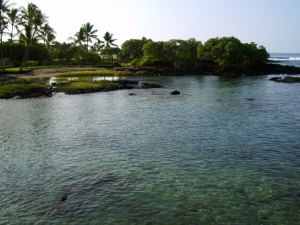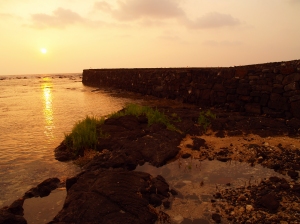The recently restored Hapaiali'i Heiau (Temple for Elevating Chiefs), a heiau associated with ceremonies involving changes in rank of Ali'i, lies on the grounds of the Keauhou Ohana Beach Resort, across the narrow tidal inlet from Ke'eku Heiau. Until recently, the temple appeared to be noting more than a disorganized pile of rocks in a tangle of mangrove and keawe. Not much is known about this Heiau and oral traditions in the area are contradictory; some local stories hold that it predates Ke'eku Heiau; other family traditions maintain it was built around 1812 by Kamehameha the Great. During restoration, carbon dating of material recovered indicated that the Heaiu may have been erected, or substantially rebuilt, between 1411 and 1465. According to cultural kahuna overseeing the reconstruction it took thousands of commoners about 10 years to build the original temple.
The temple was reconstructed by using survey maps made of the area in 1906 and 1952 and currently measures 100 feet by 150 feet. Completely surrounded by the sea at high tide and constructed entirely by dry-stack masonry, this reconstruction reminds us of the engineering sophistication of the Hawai'ians and the grandeur and beauty of the temples they erected.
During the restoration project, funded by Kamehameha Schools, it was discovered that Hapaiali'i Heiau also served as a solar calendar. On the winter solstice, from a vantage point directly behind the temples center stone, the sun sets directly off the southwest corner of the heiau; at the vernal equinox, the sun sets directly along the centerline of the temple and at summer solstice, it sets off the northwest corner. If you are visiting Hawaii during any of these seasons it is worth the trip to Hapaiali'i Heiau to see how well this ancient astronomical observatory still serves its function. More information about the Keauhou Historic District can be found by visiting the Keauhou Kahalu'u Heritage Center at the Keauhou Shopping Center, open daily from 10 a.m. to 5 p.m.
From Kahalu'u Beach, walk onto the Keauhou Ohana Beach Resort property through the gateway in the fence between them and follow the asphalt path to the pool deck, through the lobby of the resort and join the paved path that runs along the end of the Resort driveway. From the Resort parking lot, walk up the drive to the paved path that runs along the end of the driveway. Following along this path, one passes Punawai Spring first, then, where the path runs around the end of the tennis courts the homesite of the Mo'o Twins. Continuing on the path until it ends at a large tidal pool, the Hapaiali'i Heiau is immediately between you and the ocean. Across the tidal pool is the equally fascinating Ke'eku Heiau and the nearly deserted Makole'a black sand beach. Take a moment to stroll south and seaward over the tidal flats from Ke'eku Heiau and search out the large and fascinating petroglyph field at low tide (more information here). Remember that these are holy religious sites to modern native Hawai'ians; to not trespass, walk or climb on the temple proper; take nothing but photographs, leave nothing but footprints.
[youtube=http://www.youtube.com/watch?v=bcqFeWHHuyU]
For more information on traveling to Hawaii in general, and exploring the ancient temples of the Big Island in particular, please also visit www.tourguidehawaii.com and www.tourguidehawaii.blogspot.com.
Video written and produced by Donald B. MacGowan; all media copyright 2009 by Donald B. MacGowan, all rights reserved.



